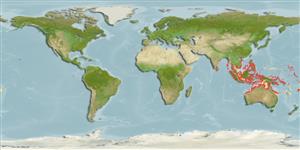>
Syngnathiformes (Pipefishes and seahorses) >
Syngnathidae (Pipefishes and seahorses) > Nerophinae
Etymology: Doryrhamphus: Greek, dory = lance + Greek, rhamphos = bill, beak (Ref. 45335).
More on authors: Herald & Randall.
Environment: milieu / climate zone / depth range / distribution range
Ekologi
laut berasosiasi dengan karang; kisaran kedalaman 0 - 35 m (Ref. 1602). Tropical; 19°N - 29°S
Western Central Pacific: Gulf of Thailand to the Solomon Islands, north to the Philippines, south to Queensland; Belau and Truk in Micronesia.
Size / Weight / umur
Maturity: Lm ? range ? - ? cm
Max length : 14.0 cm TL jantan/; (Ref. 48635)
Duri punggung (Keseluruhan (total)): 0; duri punggung lunak (Keseluruhan (total)): 22-25; Sirip dubur lunak: 4. Superior trunk and tail ridges discontinuous; inferior trunk ridge ending on anal ring; lateral trunk ridge continuous with inferior tail ridge; body rings 16; tail rings 21-23.
Found in tide pools and reef crevices. Also found in sheltered inner reefs, usually in caves with sponges and below large plate corals. Ovoviviparous (Ref. 205). The male carries the eggs in a brood pouch which is found under the tail (Ref. 205). Very active cleaner and has cleaning station that is visited by apogonids and damsels where adults work in pairs (Ref. 48635). Minimum depth from Ref. 58018. Solitary or in pairs (Ref 90102).
Male carries the eggs in a brood pouch (Ref. 205).
Myers, R.F., 1991. Micronesian reef fishes. Second Ed. Coral Graphics, Barrigada, Guam. 298 p. (Ref. 1602)
Status IUCN Red List (Ref. 130435)
ancaman kepada manusia
Harmless
penggunaan manusia
informasi lanjut
AcuanBudidaya airprofil budidaya airStrainGenetikaElectrophoresesDiturunkanPenyakit-penyakitPengolahanNutrientsMass conversion
mitraGambarStamps, Coins Misc.Suara-suaraCiguateraKecepatanTipe renangArea insangOtolithsOtakPenglihatan / visi
Alat, peralatan
laporan khas
muat turun XML
Sumber internet
Estimates based on models
Preferred temperature (Ref.
123201): 25.9 - 29.3, mean 28.7 °C (based on 2406 cells).
Phylogenetic diversity index (Ref.
82804): PD
50 = 0.5078 [Uniqueness, from 0.5 = low to 2.0 = high].
Bayesian length-weight: a=0.00085 (0.00032 - 0.00224), b=3.04 (2.81 - 3.27), in cm total length, based on LWR estimates for this (Sub)family-body shape (Ref.
93245).
Trophic level (Ref.
69278): 3.9 ±0.5 se; based on size and trophs of closest relatives
Daya lenting (Ref.
120179): Tinggi, Waktu penggandaan populasi minimum kurang dari 15 bulan (Preliminary K or Fecundity.).
Fishing Vulnerability (Ref.
59153): Low vulnerability (10 of 100).
Nutrients (Ref.
124155): Calcium = 135 [77, 258] mg/100g; Iron = 1.09 [0.62, 1.83] mg/100g; Protein = 17.7 [16.5, 18.9] %; Omega3 = 0.117 [0.065, 0.214] g/100g; Selenium = 35.2 [18.0, 79.8] μg/100g; VitaminA = 109 [38, 317] μg/100g; Zinc = 1.7 [1.1, 2.5] mg/100g (wet weight);
